Learn faster, study better with Richard Feynman's Learning Technique
Updated on 29 May 2023 • 4 min read
We are facing a lot of challenges during our studying process. We're usually having a hard time remembering and understanding complicated concepts. Nowadays, it is really important to know how to learn things as productive as possible. Feynman's technique is aimed to help organize material in your head and assimilate it.
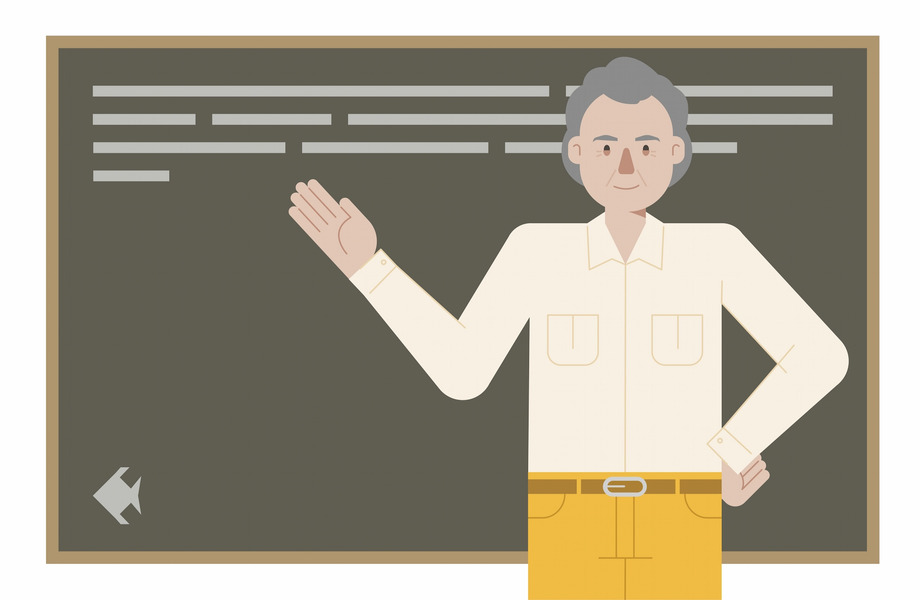
Before you start learning about a unique Feynman's technique, you need to get to know him better. Here's a clear image of who he is and what he became famous for.
Richard Feynman is well-known for his achievements in theoretical physics and other sciences, such as biology and chemistry. We can confirm it by seeing his involvement in the Manhattan Project and, what's significant, obtaining the Nobel Prize in Physics. You might recognize his name from his famous books “Surely You're Joking, Mr. Feynman!” and “What Do You Care What Other People Think?”. Many of his lectures were captured and published as books. But lots of people also described him as one of the best teachers they had ever seen. What's his secret?
The main point of his learning philosophy is to explain an extremely complicated concept using simple language as much as possible. He thought that automatic repeating is not the best learning path. Feynman chose Form over Function and discovered a lot of different techniques which will include more interaction with your subject: improving your memory by reviewing or teaching somebody. Remember about clear thinking (information by itself) and clear presentation (the form you pick to deepen understanding).
What is the Feynman technique
The Feynman technique is a method that helps you to break down complex concepts and explain them in a clear and simple way. The main idea is to grab something incomprehensible and try to clarify it by explaining it as if you were talking to a child. Whether you're a student, a teacher, or a professional, the Feynman technique is a valuable tool that can help you to master any subject.
How to use Feynman's technique
The concept of this method it's a simple cycle of 4 steps that you need to apply:
- Choose a concept.
- Imagine you're a school teacher.
- Identify your gaps.
- Review + simplify.
Feynman Technique Steps
Here you can see the rules that Feynman followed every time he needed to learn and assimilate new information.
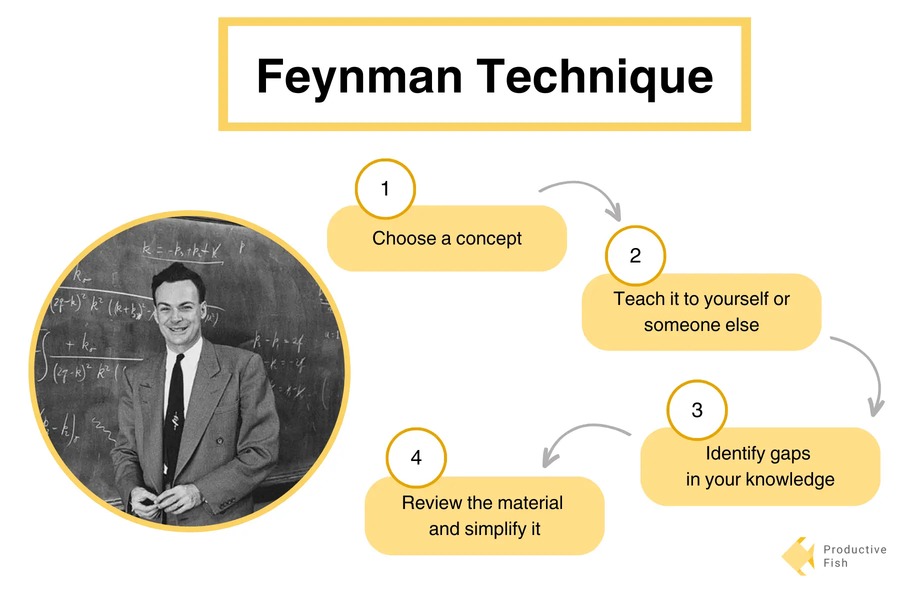
Choose a concept
Write the name of it on a blank sheet of paper. Lay down several headlines. Try to maintain the briefest form. And each time you come across new sources of information, add them to the notes.
Imagine you're a school teacher
Of course, in the context of explaining the concept to children. Consider your information as working material, where the biggest goal is to make every part of your explanation simple and clear for the ordinary middle-schooler. This exercise is aimed to help you select the best words for your perception.
Identify your gaps
Be attentive. Work through this material again and again, until you'll be sure you can understand and explain everything you just learned. But don't stop just repeating. It won't help at all if this concept is not clear in your head from the outset. Find new ways to understand and structuralize, for example, you can come up with some new original associations or another way to make a note. The changing approach can measurably increase your level of understanding.
The work with your gaps is one of the most essential parts on your way to becoming an expert in a desirable field. Try to find some new sources to reach a more comprehensive view, or you can use previous ones.
Review + simplify
Feynman believed in communication as a studying tool. Also, he believed that telling a story can noticeably improve our understanding and shore up all knowledge. Review yourself in between information blocks, and then you can entrench it by using another method, for instance, a quiz.
After all, simplify. Remember that all complicated terms consist of smaller ones. Try to discover it, and find similarities that can help on your way of getting clarity of the topic in your mind.
Example of the Feynman Technique in Action
Now we are going to use the Feynman learning technique. As an example topic, we take the Pomodoro technique.
Step 1: Write down the name of the concept.
It is better to make all notes on real paper and with a pen, as you’ll remember more when you do it the old-fashioned way.
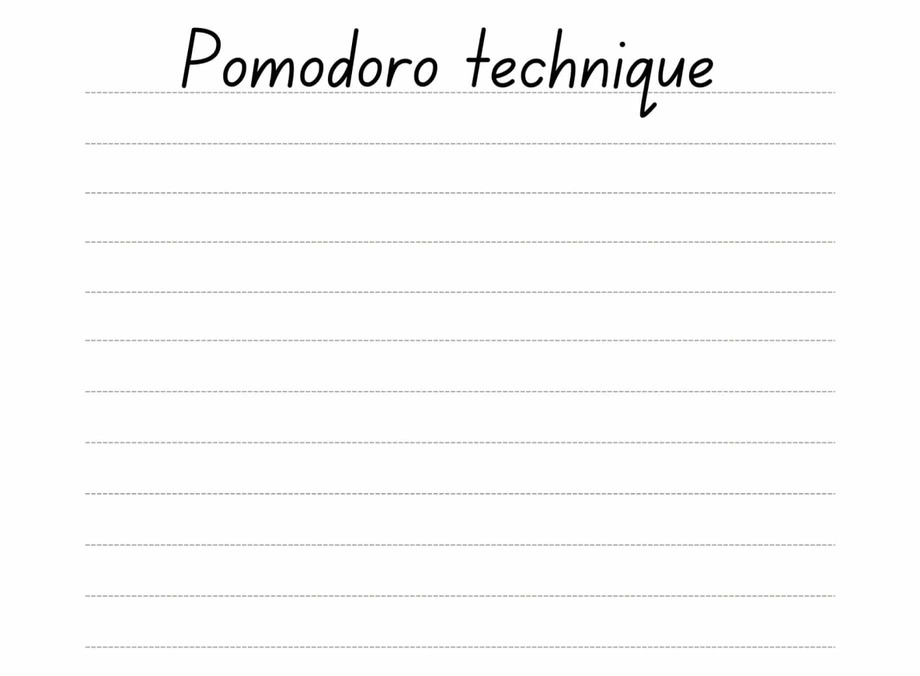
Step 2: Note the explanation.
Write the description shortly as though you were teaching someone. Grab some explanations from Google by searching “what is …?” Noting a few sentences about the topic will help to identify what is familiar to you or not.
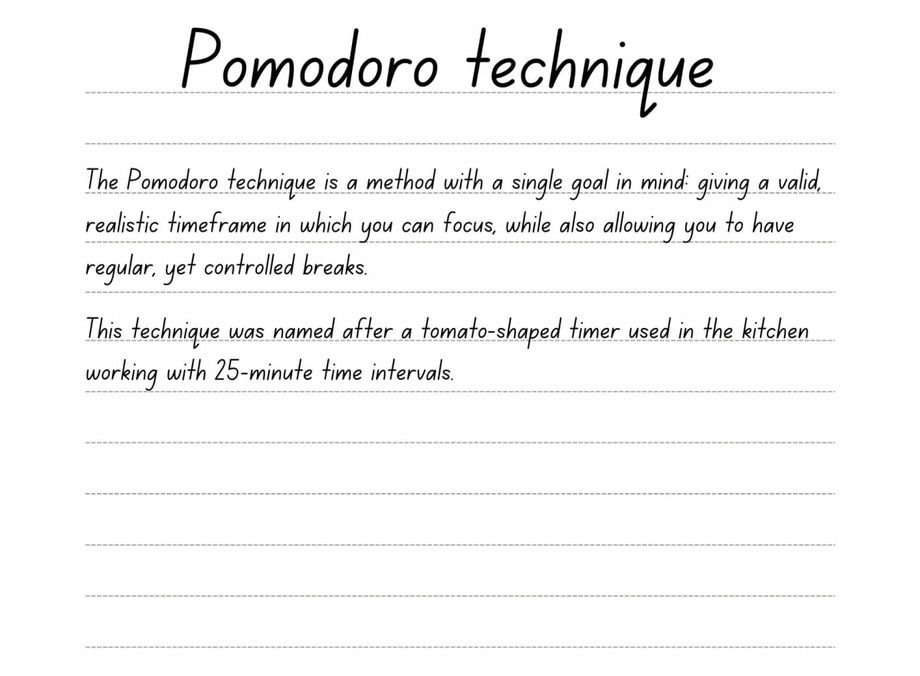
Step 3: Find the gaps.
You may have a basic understanding of the topic, so we have to make a list of questions to find the gaps. Imagine that you are asking someone.
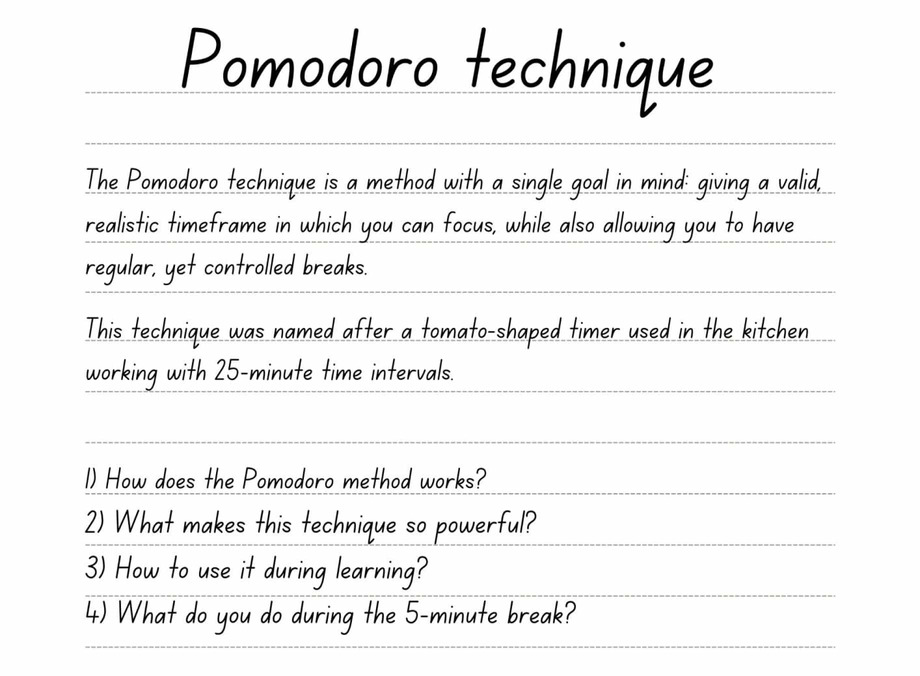
After identifying knowledge gaps, we should research and write down more notes.
Step 4: Simplify your notes.
As we mentioned, telling a story can noticeably improve our understanding and deepen our knowledge. You may review between noted information and then consolidate what you've learned using another method such as a quiz.
Simplify your text. Get rid of any acronyms that can be incomprehensible. Try to replace them with similarities that can help you get clarity of the topic in your mind.
Why Feynman`s technique can be useful?
All those tips are generic information gathered from Feynman's books and lectures, so it'll be great for you to consider the source of his concepts. Be sure you will find much more than abstract and theoretical things about physics or math, moreover, Feynman wanted everybody to understand these things. And this is why he created his books and lectures.
The uniqueness of his techniques is in simplicity. Following his rules and exploring your ways of learning will make you a better student. During all of these exercises, you teach yourself several times more. When you discover some methods, especially for your brain, you invest in your future productivity. With this approach, you'll be more prepared for the study difficulties and complex principles, because you'll know how to deal with this kind of information.
To Sum Up
The Feynman method is your answer if you have always wondered how to simultaneously learn something easy but complex. It can be applied to any sphere where you want to be more productive. This technique is unique because of its simple 4 steps and is quite versatile in use. So go ahead with those steps, use them whenever you need them and continue improving yourself without stopping.